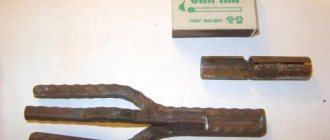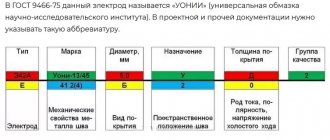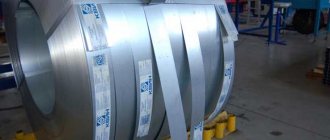The entry into the market of compact machines for semi-automatic welding and their high popularity have contributed to the expansion of the use of welding in almost all spheres of human life. Thus, with the help of semi-automatic, various car body repairs are carried out. Welding is also used in industrial or private construction. They are used to produce various metal structures.
In the process of working with the device, some components tend to wear out and become unusable. One of these components of this equipment is a sleeve for a semi-automatic welding machine. During operation, elements are subject to various external factors:
- High temperatures during welding.
- Drops of molten metal.
- Scratches.
- Various bends.
Inside the sleeve, its guides are abraded by the wire, which is fed to the welding zone. Naturally, all these influences adversely affect the device and disable it. Often, the sleeve for a semi-automatic welding machine is the first to break.
Types
Modern manufacturers today offer two types of welding hoses. This could be a hose itself or a burner. However, the appearance of these products is no different from each other. Both of these names refer to the same accessory.
Thus, a semi-automatic welding torch-sleeve consists of three main elements. This is the burner itself, the hose, as well as connectors for connecting them. Unfortunately, it is now difficult to find sleeves for sale separately. But you can purchase almost all the components of the design or find analogues.
Buying a sleeve
It is difficult to surprise with the variety of models of such a popular product. The more difficult it is to choose the right sleeve. You can order it online, or you can come to a specialized welding equipment store. As a last resort - if you are confident in your knowledge - go to the nearest instrument market.
You can focus on the price: if a semi-automatic machine is used sporadically - from time to time, then you probably shouldn’t buy an overly sophisticated model for several hundred bucks. In this case, the budget can be $50, no more.
On the other hand, if your professional activity is directly related to welding, then you should not skimp on the quality of such an important part as a hose. In this case, look at sleeves costing more than $150.
This way you will protect yourself from unplanned expenses in the future.
When purchasing, we check the welding sleeve. It should be quite flexible and elastic. Beware of a product that, when folded, decreases in diameter by more than 10%. Squeezing the hose is dangerous! Blisters, cracks and other defects are also detected visually.
Particular attention should be paid to the lead-in mouthpiece. Shapes can vary and mouthpiece configuration depends on the type of welding, so it's easy to make mistakes. It is better to seek advice from the seller or other specialist.
Device
So, the sleeve for a semi-automatic welding machine consists of a rubber shell. Underneath there is a rather complex filling. Since semi-automatic welding requires a special wire, a complex system is located in the welding sleeve. It is a guide channel that feeds a spiral. There may also be a Teflon tube inside. Companies that produce components for welding may have different sleeve designs for semi-automatic welding machines.
Also, the work process requires the presence of protective gas. A separate hose is used to supply it. Depending on the brand and model of the device, the process of transporting and supplying wire and gas to the work area may vary. Along with the coaxial type, there is also a parallel type.
A positive power cable from the welding machine to the transformer also runs inside the sleeve. This cord goes to the current tip located on the torch. There are also two thin wires. They are connected to the start button.
Finishing up the budget semi-automatic
Authorization on the site
There are a lot of inexpensive semi-automatic welding machines on the market that will never work properly because they were made incorrectly from the start. Let's try to fix this on a welding machine that has already fallen into disrepair.
I came across a Chinese Vita semi-automatic welding machine (from now on I will simply call it PA), in which the power transformer burned out; my friends just asked me to repair it.
They complained that when they were still working, it was impossible for them to cook anything, there were strong splashes, crackling, etc. So I decided to bring it to a conclusion, and at the same time share my experience, maybe it will be useful to someone. Upon first inspection, I realized that the transformer for the PA was wound incorrectly, since the primary and secondary windings were wound separately; the photo shows that only the secondary remained, and the primary was wound next to it (that’s how the transformer was brought to me).
Consumables
A sleeve for a semi-automatic welding machine is a consumable material, or rather, a spiral responsible for feeding the wire. This part is also called a feed channel or a guide element.
The materials used for its production are wire or steel strip. However, the latter can also be made of plastic. The wire or tape is wound in the form of a spiral. Next, it is covered on the outside with insulating materials.
Due to the fact that the wire constantly rubs against the inner surface of the sleeve, the internal elements actively wear out. This is also facilitated by dust and dirt that gets inside along with the wire. The channel is especially susceptible to active wear if work is carried out with aluminum wire. For work with aluminum material, Teflon tubes are used.
These guide channels are “consumables” that must be changed periodically. The gas hose must also be replaced. It is prone to ruptures.
Welding sleeve
Since the mixtures are supplied to the torch under high pressure, the choice of this part should be determined primarily by the reliability of the product - after all, the safety of welding depends on it. Especially if this concerns work carried out in a private home.
The complex multilayer structure of the sleeve is made of heat-resistant and chemically resistant rubber. It is made from natural or artificial rubber with the addition of modifiers that improve the properties of rubber.
The outer layer of the material is resistant to abrasion and heat and ultraviolet radiation.
The intermediate reinforcing layer of the hose is based on artificial fiber. Hoses used for the production of sleeves for welding machines are also used in other difficult conditions.
For example, for transferring fuel and aggressive mixtures.
Such hoses are multifunctional and can be used not only in welding, but also when cutting metal. The choice of welding hose depends, among other things, on the configuration, which includes:
- Rubber hose;
- Welding gun;
- Connector
This last sleeve element is different in that it does not fit all models. This is what distinguishes, in particular, the products of some Chinese and domestic manufacturers. The Euro connector will be universal - it fits almost all semi-automatic devices.
Reasons for element failure
If a semi-automatic welding sleeve with a mechanical valve has failed or the device has received mechanical damage, the part requires repair or replacement. In order not to spend extra money, you first need to diagnose the node.
If the welding seam turns out to be of poor quality, then this directly depends on the condition of the sleeve. A bad weld can be caused by wire jamming inside the element or by insufficient gas. Both reasons are grounds for replacing the hose separately or together with the burner. The last option is rarely used. More often they buy one new element, or make a welding sleeve for a semi-automatic machine with their own hands.
What you need to know when choosing
To ensure that you do not make a mistake in choosing a welding hose, we will provide some simple tips and indicate those details that you should pay attention to when purchasing a hose.
First of all, before purchasing, you need to make sure that the product is flexible and durable. Check for manufacturing defects. Any cracks, holes, uneven layers, etc. can be called defects.
But such a check must be done carefully so as not to deform the hose with your own hands.
Based on practice, we can conclude that the most popular is the sleeve for semi-automatic cooking in an argon environment. First class hoses do an excellent job of this task.
The most convenient length, in our opinion, is 2-2.5 meters, although the maximum mark can reach almost five meters.
It is very important to ensure that the devices are not twisted or pressed down. This applies to both operation and simple storage of hoses.
In order for the hose to serve you longer while maintaining quality, it is advisable to store them in dry areas protected from dust and debris. This way the shell will retain its strength longer.
We have tried to take into account everything that is worth knowing when choosing and using gas hoses. But the main thing is to remember that a sleeve is a component that wears out over time and necessarily requires replacement.
After all, if you use the same hose for decades, it is unlikely that the necessary, high-quality result will be achieved.
Market offers and prices
The cost of the part from the kit together with the burner starts from one and a half thousand rubles. The most expensive device costs about 12 thousand. Channels for transporting wire will cost a maximum of 200-400 rubles.
If you need a Teflon tube, then it costs a maximum of 500-1000 rubles. Domestic sleeves can be purchased for 20-40 rubles. for each linear meter. The diameter of this hose is 6.3 mm. Therefore, it is not necessary to purchase the sleeve as a set. From purchased consumables you can make an excellent homemade sleeve for a semi-automatic welding machine.
Properly stored and used
In order to go without repairing welding equipment for as long as possible, it is necessary to follow basic rules of operation and storage. So, when working, you need to avoid contact with molten metal on the sleeve, and also protect it from flames and aggressive substances. Protective covers are designed for this.
The sleeve also does not like squeezing, twisting, or fractures. After work, having previously removed the remaining working mixtures from it, fold it separately - in a dry, cool place protected from the sun. This way it will last longer.
More on this topic on our website:
- What is the price for semi-automatic welding machines - we buy semi-automatic welding machines cheaply with a guarantee. Semi-automatic welding machines are used for welding ferrous and non-ferrous metals with mechanical feed of welding wire and manual feed of torch...
- Kaiser welding - inverter welding machine - characteristics Kaiser welding is not very well known among professional welders. However, this device has good technical parameters, a reasonable price and an excellent set of functions. Areas of use…
- Welding helmet Chameleon - reviews, prices, where to buy Professionalism is distinguished not only by experience and knowledge, but also by the use of high-quality equipment. For a welder, this includes a protective mask. What is the difference between a welding helmet...
- Welding wire for semi-automatic machines - price and where to buy it Electrode wire is the main consumable material when welding with a semi-automatic inverter. What types of welding wire for semi-automatic machines are there, the price for it - we’ll look at it in our material...
Share a link to this material with your friends on social networks (click on the icons):
How to choose
When purchasing semi-automatic welding kits, there are several important factors to consider. So, you need to know the model of the device and its functions. This can be work in environments of inert or active gases, argon arc welding or work with flux-cored wire. It is worth considering how the connecting elements are arranged. The most popular option is KZ-2. The ergonomic characteristics of the burner are also important. The handle should fit comfortably in the hand, and the button should be of sufficient size.
When choosing, you should pay attention to the diameter of the wire for which this or that device is intended. With ordinary welding devices, wire with a diameter of 0.6 to 1.6 mm is used. But specific devices can work with narrower size ranges - for example, 0.2-0.6 mm.
An important point when choosing is the maximum currents and sleeve thickness. Optimal for any welding work – 3 mm. But on sale you can find products of longer length.
Varieties
Hoses for gas welding and metal cutting can be of three types. They are usually divided into classes: 1, 2 and 3.
The first class is designed to work with acetylene, propane and butane. Maximum pressure 0.63 MPa. The outer shell of the hose is painted red so that you can easily distinguish it from the rest.
Second class hoses are used for supplying liquid fuel. It can be gasoline, white spirit or kerosene. The hose is painted yellow.
The third class is designed to supply oxygen. They are painted blue.
Also note that welding sleeves may be painted black. This means they are suitable for all types of work.
Pay attention to the temperature conditions under which this hose can be operated. There are two types: for work in normal conditions (the hose can withstand temperatures not lower than -35 degrees and not higher than +70) and for work in cold climates (not lower than 55 degrees).
All this information can be read on the hose itself, since there are always markings there. It indicates what kind of product is in front of you, what its class, diameter, design pressure and temperature conditions are.
Marking example: III-9-2-ХЛ GOST 9356-75.
It means that you have a third class welding hose, diameter 9 mm, pressure 2 MPa, for welding in cold conditions. The following is GOST, which regulates this marking.
Requirements for operation
The ends of reinforced welding hoses, when put on a nipple, must withstand tension of up to 30% of the internal diameter without breaking.
All hoses must maintain tightness when exposed to pressure twice the rated value, and also have a three-fold tensile strength reserve under hydraulic pressure.
The standard average service life of welding hoses, according to GOST 9356-75, is 18 months.
All welding hoses supplied by Centrogaz have a certificate confirming compliance of all product parameters with the requirements of GOST 9356-75.
Classification of classes, parameters and sizes of oxygen hoses
Currently, 2 classes of special products are produced, in the form of a simple sleeve or as a multifunctional cable complete with a gas burner. The latter are universal in purpose and are equipped with: a hose with a built-in welding gun-torch and a special connecting connector. This kit is suitable for a semi-automatic process that requires the wire to be fed to the processing site along a guide channel with a compressed spiral. The inner surface of which is usually strengthened to protect the structure with a special tube made of wear-resistant materials, such as Teflon.
In addition to the traditional single-channel transmission method, the hoses can also operate according to the parallel supply principle. In this case, several channels are placed simultaneously in one coaxial cable. The permissible length of welding hoses is from 8.0 to 20.0 m; it is prohibited to use hoses shorter than 9.0 and longer than 30.0 meters during work. Certain tolerances for increasing the length are allowed for large slip structures up to 40 m, and above 40 m, a special permit for work will be required in the presence of the person responsible for safety.
It is permissible to lengthen the sleeves with nipples made of steel or brass, while in order to avoid breakdown and leaks, the sleeves with nipples are additionally secured with soft types of wire. The length of the connecting sections cannot be less than 3 m. It is prohibited to use smooth-bore tubes to connect structures.
Before connecting the hoses with the cutter, they must be purged with working media: oxygen, respectively, O2, and propane, with propane. During the welding process, it is prohibited to pull the hoses or step on their sections and place them near an open fire or a high-temperature source. They must also be protected from sparks. Upon completion of the process, the hoses are carefully collected onto the reel and placed on fastenings or placed in a place specially prepared for storage.











